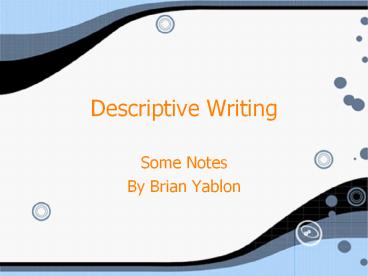Descriptive Writing - PowerPoint PPT Presentation
Title:
Descriptive Writing
Description:
Descriptive Writing Some Notes By Brian Yablon Overall Purpose You want to create an image or series of images in the reader s mind. If done well, your reader ... – PowerPoint PPT presentation
Number of Views:358
Avg rating:3.0/5.0
Title: Descriptive Writing
1
Descriptive Writing
- Some Notes
- By Brian Yablon
2
Overall Purpose
- You want to create an image or series of images
in the readers mind. - If done well, your reader should feel as though
he/she is experiencing the world through your
senses -- as though he/she were transposed onto
you.
3
A Basic Skill
- Descriptive writing is a threshold skill. It
is the basic building block of all other forms of
writing. - In order to write all types of essays well, you
must write well descriptively.
4
Some Specific Uses
- To entertain
- Such as an amusing description of a teenagers
room.
- To relate an experience.
- Such as a description of your childhood home to
convey a sense of wealth or poverty you grew up
in.
5
More Specific Uses
- To express feelings
- Such as a description of your favorite outdoor
spot so that your reader clearly understands why
you enjoy that place so very much.
- To inform (for a reader unfamiliar with a
subject). - Such as a description of a newborn calf for a
reader who has never seen one.
6
Still More Specific Uses
- To persuade, to convince readers that some music
videos degrade women. - Such as a description of a degrading music video.
- To clarify, to clear up a misconception.
- Such as the descriptions of two people, objects,
places, or ideas.
7
Where Can Descriptive Writing Be Found?
- By itself
- Narratives
- Exemplifications
- Comparison-contrasts
- Arguments
- Definitions
- Division-classifications
- Cause-effect
8
How Do You Begin?
- First, figure out two things
- Your purpose -- what are you trying to achieve
with this description? - Your audience -- who are you directing your
description toward. - Your purpose and audience determine WHAT you say
and HOW you say it.
9
Then What?
- Generate as many ideas, details, examples, and
images as you can -- more than you think youll
need.
- Select which of those you want to use.
- You cannot use everything its too much -- and
you want to avoid sounding like a laundry list.
10
Focus on a Dominant Impression
- Support the dominant impression with specific,
vivid, precise details that all lead toward that
overall image.
11
Getting Organized
- There are three ways to organize a descriptive
essay. - Keep in mind that organization patterns tend to
overlap.
12
Spatial Organization
- This is organizing your images in physical space
- Top to bottom
- Front to back
- Left to right
- Near to far
- Head to toe
- Bumper to bumper
13
Chronological Organization
- Sequential order
- First to last
- Morning-noon-night
- First, second, third
- Monday, Tuesday, Wednesday
- September, October, November
- 1999, 2000, 2001
14
Emphatic Organization
- Order of importance
- Least to most
- Most to least
15
Then What?
- Express and explain your details in length and in
depth. - Avoid creating a laundry list of characteristics.
- Use sensory language. We are sensory creatures
and experience our world with our senses. - Hearing
- Taste
- Touch
- Sight
- Smell
16
Be Aware of
- The power of words.
- Denotation (literal, dictionary definitions)
- Connotation (associations we make with words)
- They are often not the same -- and sometimes
opposite!
17
You Gotta Be Smooth, Baby!
- Be aware of transitions they help your reader
move between ideas. - Theyre connectors between sentences and between
paragraphs.
18
Do You Feel Like I Do?
- Use sensory language
- Hearing
- Tasting
- Touching
- Smelling
- Seeing
- Be aware that sensory language enlivens your
writing but also slows it down. - Use it well but sparingly.
19
Precision, Precision
- Always be vivid, specific, and precise with
details. - Use concrete details instead of amorphous, vague
ideas.
20
Figurative Language
- Try to use
- Metaphors
- Similes
- Personification
21
Sentences
- Vary sentence
- Length
- Short
- Medium
- long
- Structure
- Simple
- Complex
- Compound
- Compound-Complex
22
Focus
- Remember that descriptive writing is focused on
images NOT EVENTS. - Think of it as flipping through a photo album.
Each image is static yet tells a story.































